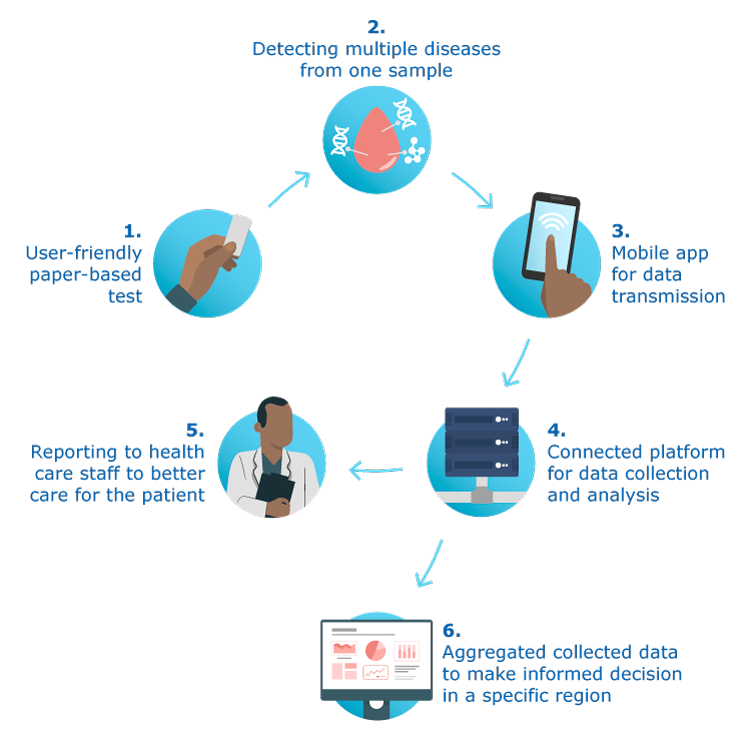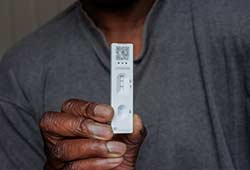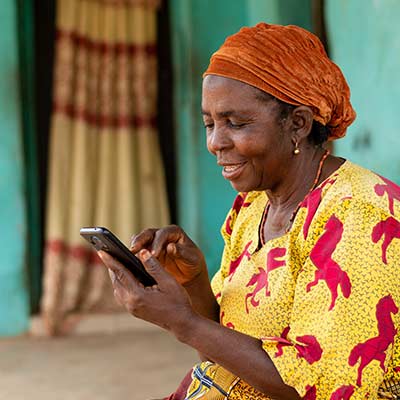Improving disease diagnostics in Africa
DIDIDA, or Digital Innovations and Diagnostics for Infectious Diseases in Africa, is a European Union and United Kingdom Research and Innovation funded project developing reliable, low-cost and mobile phone-connected tests to help detect multiple diseases at once in sub-Saharan Africa.
This collaborative project between Europe and Africa also aims to strengthen research and innovation capacity in Africa through training, staff exchanges, PhD scholarships and events.

The DIDIDA project
1
Detecting multiple diseases at once with new, highly sensitive tests
2
Collecting data and assisting health professionals with app-linked diagnostics
3
Improving research capacity in Africa through collaboration

About the consortium
The consortium has been drawn together to provide the expertise and momentum to deliver a step change in infectious disease diagnostics, digital medicine and mobile health technology.
Key figures
Countries involved from Europe and Africa


6M€ from EU and 2M€ from UKRI
PhDs funded


Project delivery
News & Events
Didida to Host Digital Health Hackathon in Uganda
Didida to Host Digital Health Hackathon in UgandaWe are excited to announce the launch of a series of nine events aimed at citizens, students, and businesses, starting with a hackathon in Kampala, Uganda. Scheduled for June 28th and 29th, 2025, at Makerere University...
Strengthening Epidemic Data Accuracy in Africa: Insights from the 1st Quarter 2025 ConnDx Data Review Workshop in Kisumu, Kenya
Strengthening Epidemic Data Accuracy in Africa: Insights from the 1st Quarter 2025 ConnDx Data Review Workshop in Kisumu, KenyaMarch 5, 2025 | Kisumu, KenyaAs part of its collaboration with the Kisumu Department of Health (DoH), Didida is regularly organizing update...
Impact of Climate Change on the Spread of Infectious Diseases: Analysis of Trends and Forecasts
Impact of climate change on the spread of infectious diseases- Analysis of trends and forecastsClimate change is a defining issue of the 21st century, with widespread consequences for ecosystems, economies, and human health. The relationship between climate change and...
Infectious diseases remain the leading cause of death in Africa, while non-communicable diseases are on the rise
At the same time, NCDs are putting increasing pressure on healthcare services. Non-communicable diseases (NCDs) such as cancer, cardiovascular disease and diabetes are increasingly becoming the leading cause of death in sub-Saharan Africa.
Improving detection and prevention tools is an important measure to reduce the growing burden of these diseases, especially in areas far from health care centres.

What are infectious diseases?
Infectious diseases are caused by micro-organisms: bacteria, viruses, parasites and fungi. They can be transmitted directly or indirectly from one person to another, for example through insect bites, ingestion of contaminated water or food…

What is the burden of non-communicable diseases?
Non-communicable diseases such as cancer, cardiovascular disease and diabetes are increasingly becoming the leading cause of death in sub-Saharan Africa. They were responsible for 37% of deaths in 2019, up from 24% in 2000 according to the WHO…

What is a lateral flow test?
Lateral flow tests are a fast, reliable and low-cost tool for disease testing. A swab is taken and mixed with an extraction fluid, then a drop of this mixture is placed in a a small device. If protein or nucleic acid (DNA or RNA) of a disease is detected, a red line appears…
Want to know more?
Are you a student and you want to learn more? A researcher seeking to consult our publications? A citizen eager to better understand the issues? A decision-maker who can promote this innovation? A journalist looking for an engaging story to tell?






